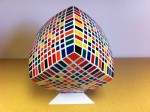Scientists develop algorithm to solve Rubik’s cubes of any size

A computer solving a Rubik’s cube? P’shaw. Doing it in 10.69 seconds ? Been there, record set. But to crack one of any size? Color us impressed. Erik Demaine of MIT claims to have done just that — he and his team developed an algorithm that applies to cubes no matter how ambitious their dimensions. Pretty early on, he realized he needed to take a different angle than he would with a standard 3 x 3 x 3 puzzle, which other scientists have tackled by borrowing computers from Google to consider all 43 quintillion possible moves — a strategy known simply as “brute force.” As you can imagine, that’s not exactly a viable solution when you’re wrestling with an 11 x 11 x 11 cube. So Demaine and his fellow researchers settled on an approach that’s actually a riff on one commonly used by Rubik’s enthusiasts, who might attempt to move a square into its desired position while leaving the rest of the cube as unchanged as possible. That’s a tedious way to go, of course, so instead the team grouped several cubies that all needed to go in the same direction, a tactic that reduced the number of moves by a factor of log n , with n representing the length of any of the cube’s sides. Since moving individual cubies into an ideal spot requires a number of moves equal to n ², the final algorithm is n ²/log n . If we just lost you non-math majors with that formula, rest assured that the scientists expect folks won’t be able to apply it directly, per se, though they do say it could help cube-solvers sharpen their strategy. Other that, all you overachievers out there, you’re still on your own with that 20 x 20 x 20. Scientists develop algorithm to solve Rubik’s cubes of any size originally appeared on Engadget on Fri, 01 Jul 2011 12:57:00 EDT. Please see our terms for use of feeds . Permalink


Posted by
on July 2, 2011. Filed under
News,
Tech.
You can follow any responses to this entry through the
RSS 2.0.
You can skip to the end and leave a response. Pinging is currently not allowed.

